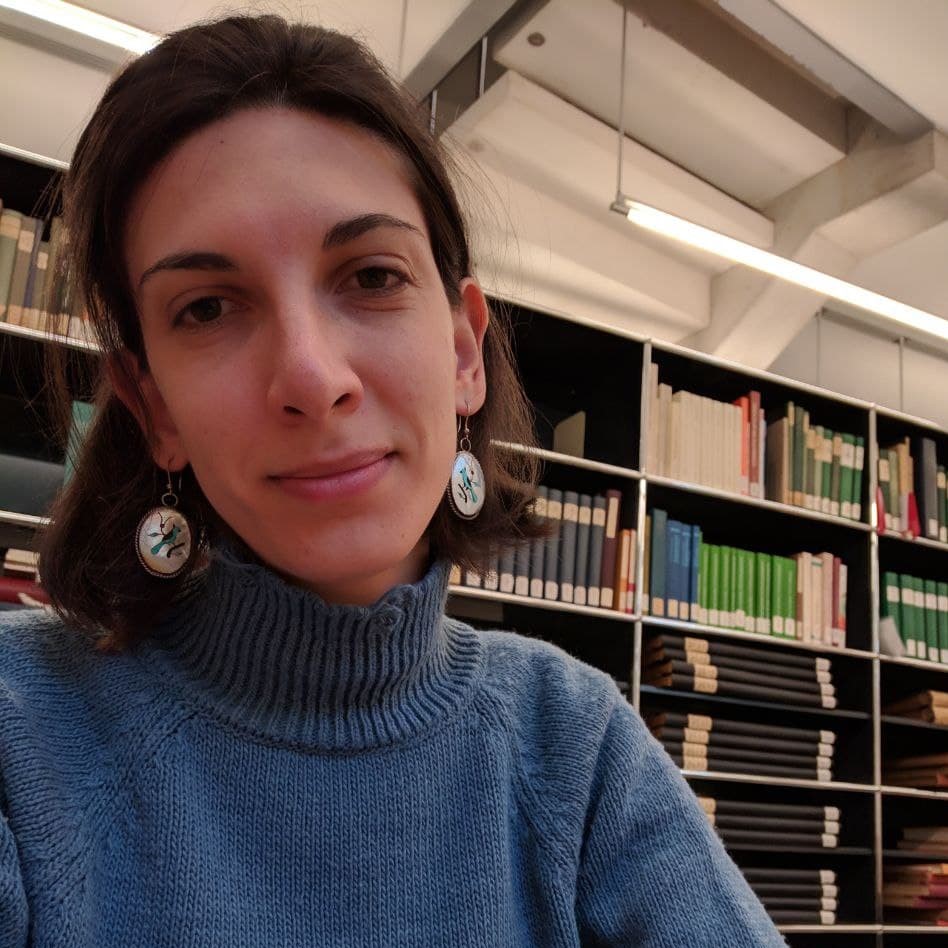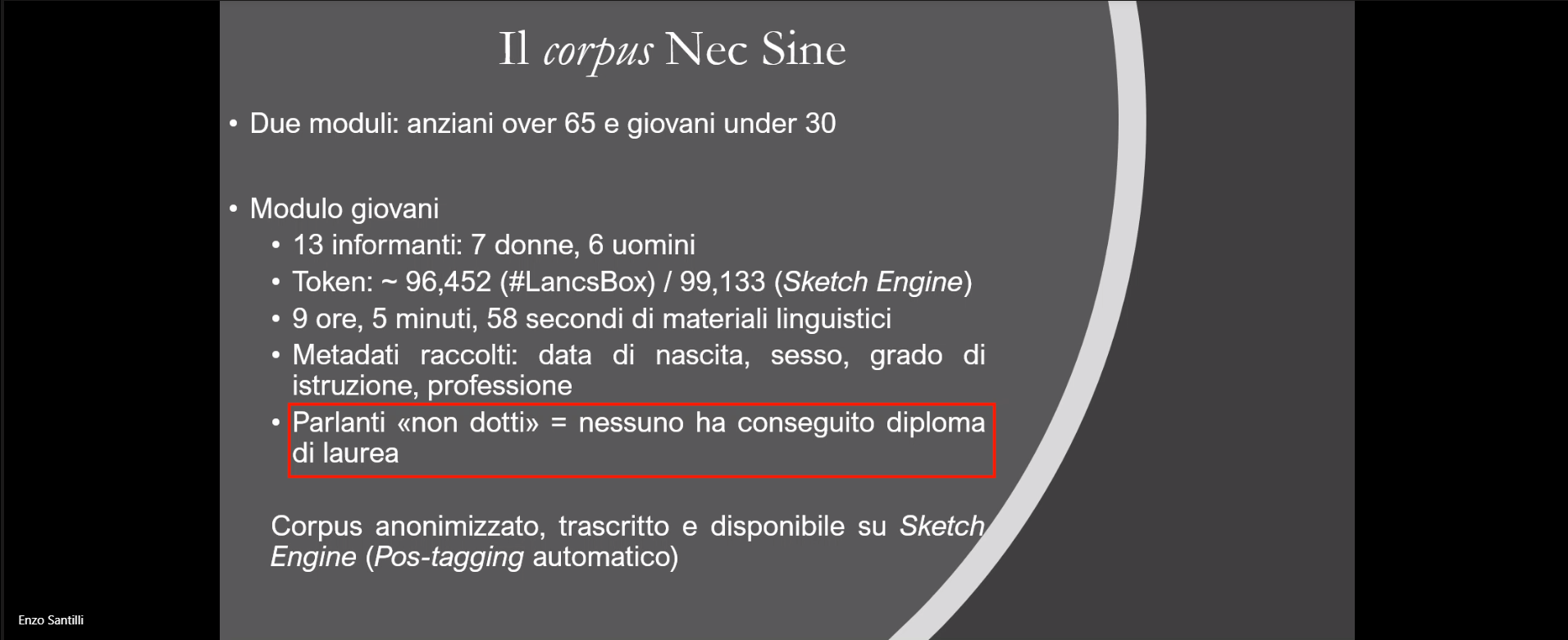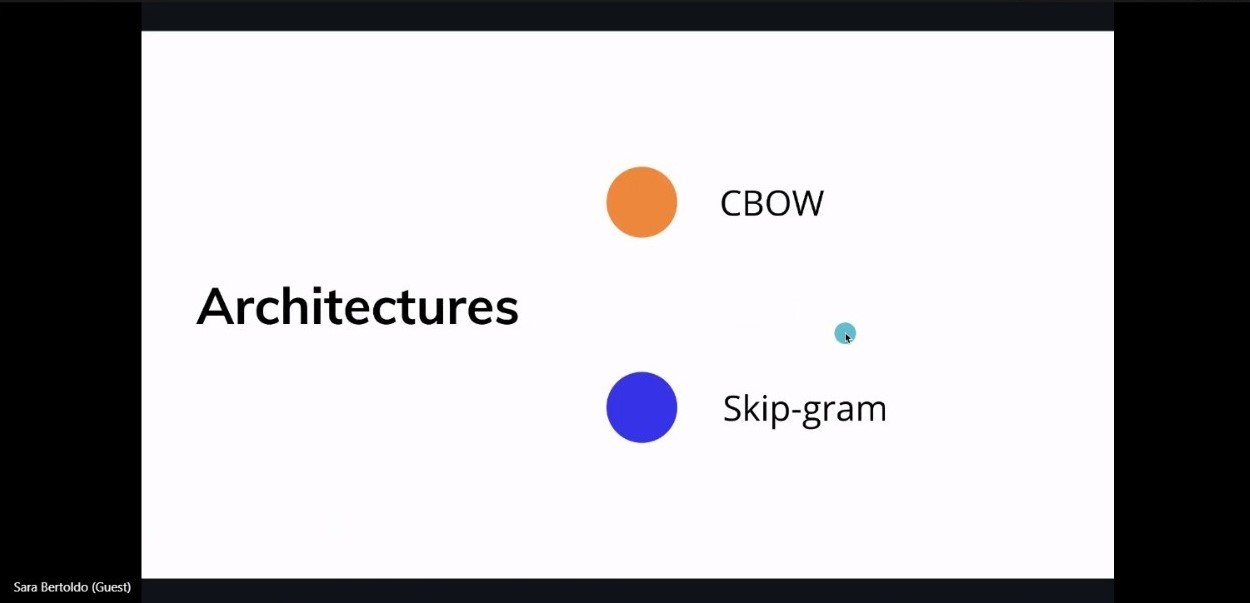🔎ᴄʜᴇ ꜰɪɴᴇ ʜᴀ ꜰᴀᴛᴛᴏ ʟᴀ ᴛᴜᴀ ᴛᴇꜱɪ?
Spendiamo dai 4 ai 12 mesi per scrivere tesi di laurea interessantissime che poi vengono
discusse per soli 15-20 minuti nel corso della sessione di laurea.
Dopo quei 15 minuti di gloria abbandoniamo le nostre tesi per sempre lasciandole fluttuare
nel cloud insieme a foto e vecchi appunti.
Abbiamo pensato a ParenTesi come a un'occasione per ridare vita alle tesi di laurea,
rimetterle in discussione e creare un ambiente creativo dove possano nascere nuove idee e
spunti di riflessione.
Cos’è ParenTesi Linguistiche ?
◾ Una parentesi rispetto alla routine quotidiana per parlare di Linguistica
◾ Un’occasione per condividere i propri risultati di ricerca al di fuori dell’ambito
accademico
◾ Un momento per mettersi in gioco e confrontarsi con gli altri
◾ Un modo per tenersi aggiornati e trarre ispirazione per nuovi progetti o future tesi
Gli Speaker di Parentesi 2021:
Titolo Tesi
Aquamotion verbs in ancient Greek: a study on pléō and its
compounds
Abstract
The present work arises from Maisak and Rakhilina (2007). In my thesis, I
analyze the Ancient Greek verb pléō and its 45 compounds, after collecting
samples which differ in quality and quantity. My analysis is carried on as
follows. Firstly, I mention the synset(s) attributed to each lemma during the
annotation of the Ancient Greek WordNet (AGWN). Then, for each verb, I discuss
the following features: (i) its Aquamotion domain(s) (following Maisak and
Rakhilina 2007); (ii) Figure and Ground; (iii) the expression of spatial
relations; (iv) verbal aspect of the occurrences; (v) the type of actionality
denoted by the occurrences. For the compounds of pléō, I also focus on the
meaning of the preverb(s). I also comment on metaphorical meanings, where
present. My analysis shows that pléō and the majority of its compounds mean
‘sail’ or ‘set sail’. Thus, in annotating these verbs in the AGWN, I have mostly
employed synsets v#01260993 | travel by boat and v#01318250 | steer away from
shore, of ships. The majority of the occurrences is inflected in the
imperfective aspect and denotes activities (cf. Vendler 1957). The Figure is
usually human, but it can also be a maritime means of transport (e.g. a ship or
a boat). Rarely, the Figure is a fish, or an inanimate object not related to the
sea (e.g. a weapon). The most expressed spatial relation is the Goal, and this
is in line with the Goal-over-Source principle (cf. Ikegami 1987).
I contatti di Andrea
Titolo Tesi
Probing the linguistic knowledge of word embeddings: A case study on
colexification.
Abstract
In recent years it has become clear that data is the new resource of power
and richness. The companies that are able to manage it to extract useful
information are the ones that are expected to last and increase their profits.
One of the ways in which data is conveyed is through natural language: every day
we produce an enormous amount of linguistic data, in written or spoken forms.
Through the help of computational resources, we can manage such a big quantity
of information, in an automatized and scaled way. Before being able to do this,
we need to find ways to allow computers to represent linguistic knowledge. This
is indeed a problem, considering that computers do not have linguistic
proficiency as we humans do.
For words to be processed by machine models, they are often required to have
some form of numeric representation that models can use in their calculations.
One method that has become influential in recent years is word embeddings,
defined as the representation of terms as real-valued vectors such that the
words that are closer in the vector space are expected to be similar in meaning.
These techniques are very popular and have shown great success in multiple
studies, but it is still not clear what kind of linguistic knowledge they do
acquire. Also, it is still an open question exactly in which way some of their
parameters affect the knowledge they acquire. The present work is motivated by
figuring it out.
We are going to test the system on a linguistic problem. The issue under
examination is colexification: the phenomenon in which, within a language,
multiple meanings are expressed by a single word form.
One of the reasons why this circumstance happens has been suggested to be a
semantic connection between the meanings. It follows that two similar meanings
are more expected to be conveyed through a single term with respect to two
meanings pertaining to completely different fields. We assume that there is a
relationship between distributional similarity and colexification, in the sense
in which the former is informative about the latter. This assumption is more
concretely based on the results from Xu et al. (2020). We use this study as a
general guide to follow in this investigation. We used some word embedding
models, specifically, fastText trained with different window sizes, to obtain
the cosine similarity values between pairs of words.
Subsequently, we performed two predictive tasks, showing how using a predictive
model like logistic regression and nothing else than the cosine similarity
values between word vectors, it is possible to predict whether a pair of
meanings is a highly frequent colexification or whether it is a colexification
at all.
The results suggest that the linguistic models in use were able to acquire a
certain knowledge as regards word meaning. Additionally, changing the model
parameter of window size, we inspected what kind of linguistic knowledge the
computational models acquired concerning colexification.
The project covered the whole working process. We started from the data
collecting, understanding and cleaning, to get to the training of the fastText
model, and evaluation of the results obtained by the predictive model.
Our findings indicate that a narrow window size value is sufficient to allow the
linguistic model to acquire a good level of semantic knowledge in a
distributional similarity task. Additionally, the parameter of window size,
depending on the task, does not always lead to different results in computation.
This raises a broader question: in which tasks does window size matter and what
does this tell us about these tasks.
I contatti di Sara
Titolo Tesi
Come fai a spiega’ a uno chə te la sušta? Tratti di italiano popolare nel
parlato di giovani non dotte/i della Marsica orientale.
Abstract
In questo lavoro si è cercato di individuare il grado di pervasività di
alcuni tratti di italiano popolare nel parlato di giovani non dotte/i
provenienti dall’area della Marsica orientale, in Abruzzo. Per farlo, si è
dapprima tracciata una summa sullo stato dell’arte della letteratura che dagli
anni Sessanta del Novecento fino ai giorni nostri ha indagato la natura
dell’italiano popolare, e si è cercato di mettere ordine nell’elenco di tratti
che ancora oggi distinguerebbero tale varietà. Si è poi data una rapida
descrizione del sostrato dialettale a cui gli informatori e le informatrici del
corpus sono stati esposti sin dall’infanzia, dato che «[u]n it. popolare
specifico sarà sempre anche un italiano regionale» (Berruto 2012[1987]: 132). Si
è poi proceduto a descrivere le modalità che hanno portato alla preparazione,
allestimento e trascrizione del corpus Nec Sine, il quale raccoglie circa nove
ore di parlato prodotto nelle interviste semi-strutturate a cui hanno preso
parte tredici giovani aventi meno di trent’anni di età e come titolo di studio
diploma di scuola superiore. Successivamente, sono stati isolati i tratti
sub-standard che le/gli informanti hanno prodotto durante le interviste,
collocandoli nello spazio di repertorio ove essi si manifestano: italiano
neo-standard, italiano colloquiale, italiano popolare. Infine, si è data una
descrizione qualitativa della misura in cui tratti esclusivi dell’italiano
popolare si manifestano nel parlato del gruppo sociale preso in indagine.
I contatti di Enzo
Titolo Tesi
English audiovisual input: a study of teenagers’ habits, attitudes and
responses to subtitling versus dubbing.
Abstract
Increased exposure to comprehensible input has long been claimed to enhance
second language acquisition. As formal foreign language classroom context alone
may not cater for all language learning, developing L2 fluency and oral
proficiency is one of the most challenging aspects for L2 learners, especially
for those coming from a context with limited L2 contact, such as Italy. The
advent of the Internet and television has changed the way people access foreign
language input, bridging the gap between L2 learners and an environment that has
limited L2 presence. Thanks to its multimodal nature, telecinematic input has
been shown to be a naturally facilitating source of incidental learning and the
growing popularity of subtitling, also in traditionally dubbing countries, has
contributed to a progressive change in the viewing habits of users. In terms of
implications for second language acquisition, attention should be paid to
out-of-class L2 input and to learners’ attitudes and behaviour towards the
foreign language.
The dissertation presents the findings of an empirical study on English
audiovisual input aimed at exploring Italian teenagers’ (n = 89, mean age = 16)
habits in terms of different audiovisual translation modalities. The study
focuses on assessing the impact of subtitles and dubbing on L2 film
comprehension, appreciation and L2 learning. Moreover, it investigates
respondents’ attitudes towards the role of out-of-school English in their
everyday lives. Results show that although they come from a dubbing country,
Italian teenagers acknowledge the beneficial impact of subtitling and welcome
out-of-school English interactions.
I contatti di Camilla
Titolo Tesi
Non solo anteriorità nel passato: le funzioni del Trapassato Prossimo in
italiano parlato.
Abstract
La tesi si propone di investigare la semantica del Trapassato Prossimo in
italiano parlato, basandosi sulle occorrenze di questa forma verbale all’interno
del corpus ParlaTO. Più precisamente, si intende discriminare tra gli usi
anaforici (perfect-in-the-past, reversed result, past-in-the-past) che la
letteratura associa al Trapassato Prossimo e accertarne l’uso in contesti di
past temporal frame, pure individuato nella letteratura. In primo luogo, si
delineano i criteri diagnostici in base ai quali classificare le occorrenze di
Trapassato Prossimo entro le quattro categorie tempo-aspettuali sopra
menzionate; una volta agita la classificazione, si esaminano i casi problematici
per individuare l’apporto di altri livelli di analisi o l’eventuale esistenza di
altri usi, più propriamente deittici, del Trapassato Prossimo (come
genericamente perfettivo o come marca di remoteness).
I contatti di Eleonora
Titolo Tesi
Le costruzioni del possesso predicativo in hindī.
Abstract
Il possesso è un dominio fondamentale dell'esperienza umana: le costruzioni
possessive si trovano in tutte le lingue finora studiate e ogni essere umano può
concepire – anche solo intuitivamente – la differenza tra “ciò che gli
appartiene” e “ciò che appartiene a qualcun altro” . Eppure, il possesso è uno
dei fenomeni linguistici più complessi. Infatti, come mostrano molti studi
tipologici (Heine 1997, Stassen 2009), le variazioni interlinguistiche rivelano
una moltitudine di configurazioni sintattiche che codificano la nozione di
possesso. Alcune lingue (principalmente lingue SAE) usano costruzioni transitive
con verbi dalla semantica "avere" per codificare la nozione possessiva; altre
lingue usano costruzioni intransitive.
La lingua hindī manca di una costruzione nominativo-accusativa (e quindi di un
verbo dal significato di "avere"), e codifica il possesso attraverso frasi
intransitive con il Possessore al caso obliquo (principalmente locativo o
genitivo). Lo scopo del mio lavoro di tesi è descrivere e analizzare le
costruzioni del possesso predicativo in hindī, e le loro proprietà sintattiche,
semantiche e pragmatiche. Le conclusioni mostreranno che ogni costruzione
possessiva in hindī è specializzata per la codifica di particolari proprietà
semantiche e che la mancanza di una costruzione nominativo-accusativa per
l'espressione del possesso può essere spiegata dall'elevata iconicità di questa
lingua.
I contatti di Lucrezia
Titolo Tesi
Aspetti fonetici, morfologici e morfosintattici del dialetto di
Roccascalegna (CH).
Abstract
Questa tesi fornisce una descrizione sincronica del dialetto di
Roccascalegna (CH), in particolare nei suoi aspetti fonetici, morfologici e
morfosintattici. I dati analizzati sono stati raccolti attraverso un’apposita
indagine sul campo, svoltasi su due informatori principali (una donna di 82 anni
e un uomo di 68 anni) e due secondari (una donna di 71 anni e un uomo di 91
anni) tramite un questionario formulato ad hoc (intervista strutturata e
semi-strutturata).
Il roccolano è del tutto nuovo a una monografia: in letteratura ne sono presenti
solo sporadici esempi in trattazioni più o meno generali sui dialetti abruzzesi.
Inoltre, l’entroterra chietino risulta nel complesso poco indagato, specie alla
luce dei più recenti sviluppi degli studi dialettologici. Alla luce della
graduale e inesorabile regressione dei dialetti italo-romanzi, si può facilmente
intuire l’importanza – sia dal punto di vista linguistico che più largamente
culturale – della loro documentazione.
Il lavoro è organizzato in quattro capitoli. Il primo introduce Roccascalegna a
livello geografico, storico e linguistico, verificando in quest’ultimo caso la
presenza dei principali tratti definitori dell’area altomeridionale. Il secondo
capitolo è dedicato alla fonetica del dialetto in esame (fenomeni del vocalismo,
del consonantismo e generali), non senza la discussione dello statuto – fonetico
o fonologico – di alcune vocali toniche. Il terzo capitolo riguarda la
morfologia e la morfosintassi del nome, dell’aggettivo, dell’articolo e del
pronome. Viene valutata anche la presenza di due sistemi di genere: quello
comune basato sulla distinzione maschile/femminile, e un secondo basato sul
tratto [±umano]. Il quarto capitolo verte sulla morfosintassi del verbo, di cui
sono messe in luce la flessione, le classi di partizione, eventualmente
morfomiche, la formazione dei vari tempi semplici e la scelta dell’ausiliare nei
tempi composti, oltre a porre l’attenzione sulla definizione della regolarità e
dell’irregolarità verbale. Chiude la trattazione un breve etnotesto in
Appendice, corredato di una traduzione letterale in nota per facilitarne la
comprensione.
I contatti di Lorenza
Titolo Tesi
Phonological Theory and Semitic Linguistics.
Abstract
The Semitic languages have been considered an extremely interesting field in
phonology since the works of Jakobson (1957) and Jakobson (1963). In this thesis
we discuss some major topics in Semitic phonology, considering in parallel the
most recent developments in phonological theory. The goal is to achieve
interesting conclusions about these topics relying on results of formal
phonology, showing the strong interface between theory and analysis.
The introduction (chapter 1) contains the theorical background of this entire
work, generative phonology, a synthetic overview on the Semitic languages taken
into account (Hebrew, Arabic, Tigre), and a brief exposition of some descriptive
problems in Semitic phonetics and phonology.
Chapter 2 presents the principles and the necessity for phonological theory in
linguistics, following its historical development from the origins (Trubetzkoy)
to the `Generative Revolution'. Then, we explain the importance of phonological
rules and the way they interact/conflict with constraints. An example
application of rules and constraints to Tiberian Hebrew is included too.
Chapter 3 focuses on one major problem in contemporary phonology, namely
opacity. After presenting the phenomenon 'per se' and in its manifestation in
various non-Semitic langugages, we deal with the particular case of Tiberian
Hebrew spirantization, comparing various theorical proposals and considering
possible solutions. We discuss various formal approaches, namely derivational,
stratal, and ``morphological''. We refuse the hypothesis that opacity is not a
real phonological problem, because empirical data show phonological opacity is
well attested across the languages of the world and, probably not being always
solvable in terms of morphological uniformity principles, a neat morphological
approach is clearly uneconomical and inadequate.
Chapter 4 offers a description of Semitic `gutturals', mainly from an
articulatory point of view. Then, the discussion focuses on the proposal of
describing the gutturals as a `universal' natural class. This proposal is in
contrast with others, like that which considers the gutturals not a natural
class as intended by McCarthy, but as a series of patternings specific to
Semitic and some non-Semitic languages, ruled out not by universal availability,
but according to phonetic feature and parameters. After a discussion on some
theorical and descriptive problems of the first proposal, we conclude that
formalization of gutturals-related and gutturals-induced processes, although
descriptively accurate to a great extent, cannot justify the existence of the
guttural as a universal natural class, but rather as a series of
language-specific patternings partly due to phonetic properties of the
gutturals.
Chapter 5 is a research proposal on a recently detected problem in Semitic
phonology, namely the occurrence of [tħ-] and [th-] in Tigre. Since this
language generally does not allow initial clusters, it is problematic, both at a
theorical and at a typological level, to explain those forms (mainly in the
imperfect inflection) which present the initial clusters mentioned above. We
think the adoption of a uniform model to explain all the phenomena common to
Tigre and the other Semitic languages taken in consideration is necessary for an
effective further research.
I contatti di Federico
 Sara Bertoldo
Sara Bertoldo
 Enzo Santilli
Enzo Santilli
 Camilla De Riso
Camilla De Riso
 Lorenza Brasile
Lorenza Brasile
 Federico Piersigilli
Federico Piersigilli

